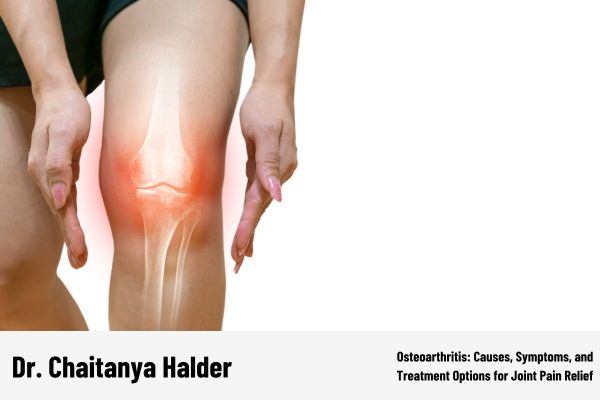Osteoarthritis: Causes, Symptoms, and Effective Treatment Options with Dr. Chaitanya Halder
Osteoarthritis (OA) is a degenerative joint disease that affects millions of people worldwide. It is characterized by the breakdown of cartilage in the joints, leading to pain, swelling, and limited mobility. As the cartilage deteriorates, bones start rubbing against each other, causing significant discomfort and stiffness. Dr. Chaitanya Halder, one of the best orthopedic surgeons, provides expert treatment for osteoarthritis, offering relief and improving the quality of life for his patients.
What is Osteoarthritis?
Osteoarthritis is the most common form of arthritis, primarily affecting older adults, but it can also develop in younger individuals due to injury, genetics, or overuse of a joint. It typically affects weight-bearing joints like the knees, hips, spine, and hands. Over time, the condition leads to reduced joint function, making everyday activities challenging.
Causes of Osteoarthritis
Osteoarthritis occurs due to the gradual breakdown of cartilage, the cushioning material between joints. Several factors contribute to the development of OA:
- Age: As people age, the cartilage naturally weakens and becomes thinner, increasing the risk of OA.
- Genetics: A family history of osteoarthritis can predispose individuals to the disease.
- Injury: Previous joint injuries, such as fractures or ligament tears, can increase the likelihood of developing OA.
- Obesity: Excess weight places added stress on the joints, particularly the knees and hips, accelerating cartilage breakdown.
- Joint Overuse: Repetitive motion and overuse of certain joints can contribute to cartilage wear and tear.
Symptoms of Osteoarthritis
The symptoms of osteoarthritis vary depending on the severity of the condition. Some common symptoms include:
- Joint Pain: Persistent pain during or after movement of the affected joint.
- Stiffness: Difficulty moving the joint, especially after periods of rest or in the morning.
- Swelling: Inflammation in the affected joint, causing it to feel tender to the touch.
- Reduced Range of Motion: A limited ability to fully move the joint, affecting daily activities.
- Grating Sensation: A feeling of bones rubbing together due to cartilage breakdown.
Diagnosis of Osteoarthritis
To accurately diagnose osteoarthritis, Dr. Chaitanya Halder, a renowned orthopedic surgeon, will conduct a thorough physical examination and may recommend diagnostic tests such as:
- X-rays: To assess the joint’s condition and look for cartilage loss.
- MRI: A detailed scan to examine the soft tissues, including cartilage.
- Joint Fluid Analysis: To rule out other types of arthritis, such as gout or infection.
Treatment Options for Osteoarthritis
While there is no cure for osteoarthritis, several effective treatment options can help manage symptoms, relieve pain, and improve joint function. With Dr. Chaitanya Halder’s expertise, patients have access to advanced treatments for OA.
1. Medications:
- Pain Relievers: Over-the-counter medications like acetaminophen or non-steroidal anti-inflammatory drugs (NSAIDs) help reduce pain and inflammation.
- Corticosteroid Injections: These can be injected directly into the joint to provide temporary relief from inflammation and pain.
- Hyaluronic Acid Injections: These injections lubricate the joint, improving movement and reducing pain.
2. Physical Therapy:
Physical therapy is essential for improving joint flexibility, strengthening muscles around the affected joint, and reducing stiffness. Customized exercises designed by an orthopedic specialist can improve mobility and help patients maintain an active lifestyle.
3. Surgical Options:
For advanced cases of osteoarthritis, surgery may be recommended:
- Arthroscopy: A minimally invasive procedure that involves removing or repairing damaged tissue.
- Joint Replacement Surgery: In severe cases, particularly in the knee or hip, joint replacement may be necessary to replace the damaged joint with a prosthetic one.
Managing Osteoarthritis at Home
In addition to medical treatments, there are several lifestyle changes that can help manage osteoarthritis symptoms effectively:
- Exercise: Low-impact exercises like swimming, walking, and cycling help strengthen the muscles around the joint and improve flexibility.
- Weight Management: Maintaining a healthy weight reduces stress on the joints, especially weight-bearing ones like the knees and hips.
- Heat and Cold Therapy: Applying heat or cold to the affected joint can help relieve pain and reduce inflammation.
- Assistive Devices: Tools like canes or knee braces can provide support and ease the strain on the joint.
Conclusion
Osteoarthritis is a chronic condition that requires ongoing management. Dr. Chaitanya Halder, a highly skilled orthopedic surgeon, offers effective treatment options that can help reduce pain, restore function, and enhance the quality of life for patients living with OA. Whether through medication, physical therapy, or advanced surgical techniques, managing osteoarthritis is possible, allowing you to continue your daily activities without the limitations of joint pain.
